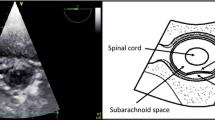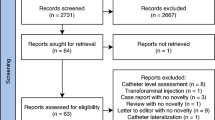Summary
Comparative measuring of epidural pressure using the Spiegelberg probe 1 and ventricular fluid pressure was carried out in 15 neurosurgical intensive-care patients. Deviations in both directions were established, with a trend toward overestimating ventricular pressure in epidural pressure measuring (r=0.77). Individual pulsations, spontaneous wave courses and therapy-induced pressure changes were reflected without delays. There were no complications observed with probe implantation periods for up to 6 days. The system has been shown to be mechanically stable and easy to implant. We believe the device to be fit for trend monitoring of intracranial pressure. As with other epidural pressure monitoring systems, false assessments of ventricular pressure may lead to wrong decisions as to the required therapy.
Similar content being viewed by others
References
Aschoff A, Betsch M, Benesch Ch, Von Haken M, Steiner H, Wirtz R (1990) Vier epidurale ICP-Transducer im Systemvergleich. Presented at the 41th Annual Meeting of the German Neurosurgical Society, Düsseldorf
Clemente G, Lazorthes Y, Aragon B, Richard J (1983) Critical study of coplanarity. The dura mater as measurement interface of the intracranial pressure by the epidural method In: Ishii S, Nagai H, Brock M (eds) Intracranial pressure V. Springer, Berlin Heidelberg New York, pp 79–83
Dorsch NWC, Symon L (1975) A practical technique for monitoring extradural pressure. J Neurosurg 42: 249–257
Esparza J, Manrique A, Lobato RD, Lamas E (1980) Simultaneous epidural and intraventricular pressure measurement during the occurrence of supratentorial expanding lesions. In: Shulman K, Marmarou A, Miller JD, Becker DP, Hochwald GM, Brock M (eds) Intracranial pressure IV. Springer, Berlin Heidelberg New York, pp 377–380
Feldman Z, Narayan RK (1993) Intracranial pressure monitoring: techniques and pitfalls. In: Cooper PR (ed) Head injury, 3rd Ed. Williams and Wilkins, Baltimore, pp 263–267
Gaab MR, Heissler HE (1984) ICP monitoring. Crit Rev Biomed Eng 11 (3): 189–250
Kosteljanetz M, Borgesen SE, Stjernholm P, Christensen L, Osgaard O, Gjerris F, Rosenorm J (1986) Clinical evaluation of a simple epidural pressure sensor. Acta Neurochir (Wien) 83:108–111
Maas AIR, deJong DA (1986) The Rotterdam teletransducer: telemetric epidural pressure monitoring. Results of comparative EDP-VFP measurements. In: Miller JD, Teasdale GM, Rowan JO, Galbraith SL, Mendelow AD (eds) Intracranial pressure VI. Springer, Berlin Heidelberg New York Tokyo, pp 207–212
Martin G (1979) Some physical principles of intracranial pressure measurement. Neurochirurgia (Stuttg) 22: 129–136
Powell MP, Crockard HA (1985) Behaviour of an extradural pressure monitor in clinical use. J Neurosurg 63: 745–749
Schettini A, Mahig J (1972) Intracranial pressure measurements and rheological behaviour of the intracranial system in dogs. J Neurosurg 37: 170–176
Author information
Authors and Affiliations
Rights and permissions
About this article
Cite this article
Czech, T., Korn, A., Reinprecht, A. et al. Clinical evaluation of a new epidural pressure monitor. Acta neurochir 125, 169–172 (1993). https://doi.org/10.1007/BF01401846
Issue Date:
DOI: https://doi.org/10.1007/BF01401846




